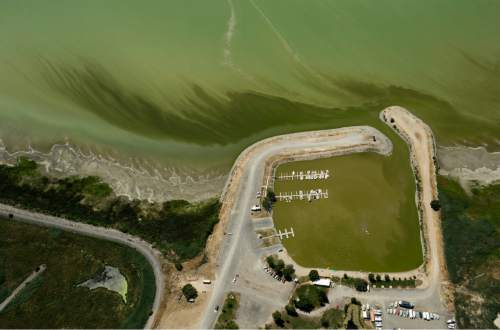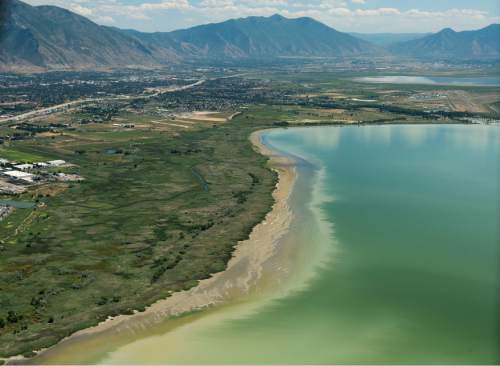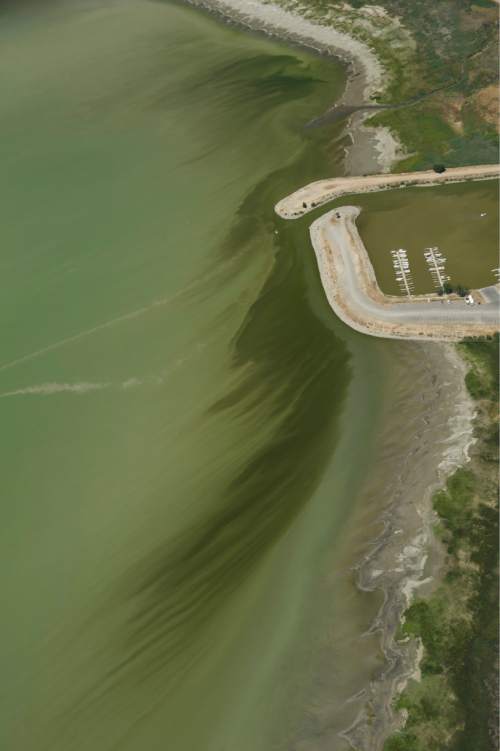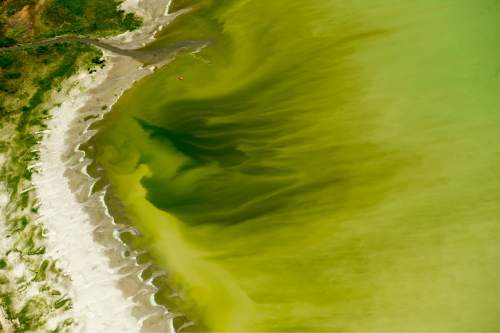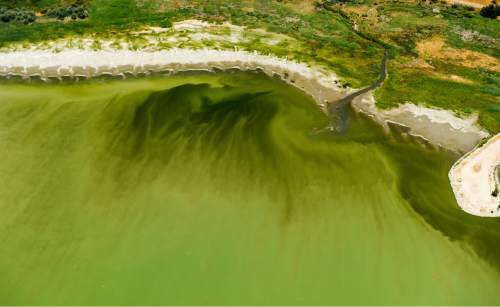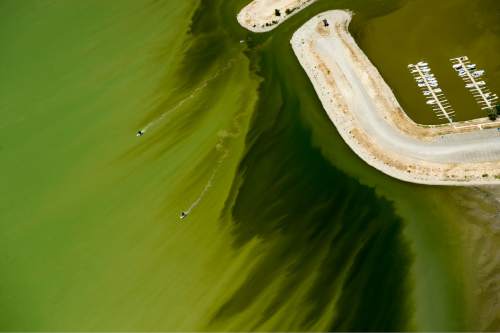This is an archived article that was published on sltrib.com in 2016, and information in the article may be outdated. It is provided only for personal research purposes and may not be reprinted.
The toxic algal bloom in Utah Lake is getting smaller but possibly more dangerous, officials say, as poisonous cyanobacteria cells release higher levels of toxins into the water as they die.
Officials are also testing water in the Jordan River and canals fed by Utah Lake to determine whether the bloom is spreading, and farmers have been urged to avoid using irrigation water that comes from the lake.
The bloom, which covers 90 percent of the lake, is the largest ever seen by a man who's been studying the lake for 40 years, said Department of Environmental Quality spokeswoman Donna Spangler.
"If not the largest, I'm certain it's one of the largest" algal blooms to ever have occurred in Utah, Spangler said.
Though the number of cells in Utah Lake's algal bloom is dropping, the majority of samples collected Thursday exceeded the "medium risk" threshold of 100,000 cells/mL defined by the World Health Organization and Utah Department of Health guidelines, according to a DEQ news release.
Algal cell concentrations ranged from 11,826 cells/mL — 2 miles east of Saratoga Springs — to 673,952 cells/mL at an area 1 mile east of Pelican Point, noted the release.
"Toxins can be at their highest after a bloom has subsided," the release warned.
Cyanobacteria can also sink and float depending on conditions, the release said, "so while blooms may not be apparent at the surface, they may still be present in the lake."
Crews from the Utah Division of Water Quality continued sampling on Utah Lake on Friday and Saturday while observing additional bloom areas from an aerial viewpoint, the release said. The blooms appeared to be moving to different areas of the lake due to winds and lake currents.
A crew took samples from Sandy Beach, Lincoln Beach, a private marina near Saratoga Springs and the Jordan River just below the diversion, as well as eight routine monitoring sites Friday, according to the release. Three sondes — underwater instrument probes — were deployed at Utah Lake State Park Marina and in open water, the release said.
Aerial surveys revealed large concentrations of algae near Pelican Point, scum deposits along Sandy Beach and algal accumulations on the east shoreline to the north and south of Utah Lake State Park, officials said.
Patches of algal mats were spotted around the lake Friday, mostly in the south, the release said, and people at the park campground began reporting strong odors.
Concerned about the potential for contaminated irrigation water, officials took samples from the Jordan River at the outlet of Utah Lake because the organism responsible for the bloom — Aphanizomenon flos-aquae — has been detected in the river previous to this incident and may be in the river now, the release said.
Salt Lake Metro Water and Salt Lake City officials planned to collect samples in the canals in the southern part of the Salt Lake Valley on Saturday.
Riverton has temporarily shut down its irrigation water, which comes from its Utah Lake-fed secondary water supply, said a Riverton City news release.
"While we have received no reports at this time regarding any safety issues, we are taking the precautionary measure," said the city news release. "We will continue to monitor the situation closely and keep [the public] informed."
The Utah Department of Agriculture and Food issued a "strong advisory" to farmers and ranchers Friday, urging them to avoid using water from Utah Lake for crop irrigation and livestock watering until lab results are available in the coming week, the DEQ release said.
The Salt Lake County Health Department reports that drinking water is not affected by the bloom, the release noted.
By early Friday afternoon, more than 100 people exposed to the bloom called the Utah Poison Control Center. Many callers reported symptoms consistent with cyanotoxin exposure — including vomiting, diarrhea, fever, skin and eye irritation, and rashes — but no definitive link has been made yet between these symptoms and the bloom, the release said.
Officials plan to notify the Centers for Disease Control and Prevention about possible human exposures to cyanobacteria from the bloom soon through the CDC's new Harmful Algal Bloom System, the release said.
Individuals who believe they may be experiencing symptoms from exposure are advised to contact their physician or the Utah Poison Control Center at 800-222-1222.
Pet owners concerned about animals should contact their veterinarian.
Twitter: @mnoblenews


